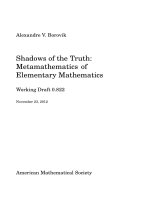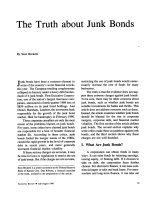Bitcoin the hype, the myth and the truth
Bạn đang xem bản rút gọn của tài liệu. Xem và tải ngay bản đầy đủ của tài liệu tại đây (540.92 KB, 28 trang )
Bitcoin: The Hype, The Myth and The
Truth
~ A Technical Overview about How Bitcoin works ~
~ Part 1 - 30/10/2017 ~
Index
●
What is Bitcoin?
Bitcoin Ecosystem
Bitcoin Fundamental
Bitcoin Transaction
Double-spending problem
The Blockchain Concept
Bitcoin Network
The Next Part
2
Disclaimer
The purpose of this Seminar is to explain How Bitcoin
works,
not to encourage you to buy Bitcoin.
3
What is Bitcoin?
●
Bitcoin is the world's first decentralized digital currency, as the system works without a
central repository or single administrator.
●
It is commonly referred to with terms like digital cash, virtual currency, electronic
currency, or cryptocurrency
●
The vision about Bitcoin was shared by a person (or a group?) under the name Nakamoto
Satoshi, with the famous whitepaper “Bitcoin: A Peer-to-Peer Electronic Cash
System”, released on 31/10/2008
4
What is Bitcoin?
I've been working on a new
What is needed is an electronic payment system based on
electronic cash system that's
cryptographic proof instead of trust, allowing any two willing
fully peer-to-peer, with no
parties to transact directly with each other without the need
trusted third party.
for a trusted third party.
Nakamoto Satoshi - 01/11/2008
Nakamoto Satoshi - 31/10/2008
Bitcoin P2P e-cash paper - The Cryptography
Mailing List
Bitcoin: A Peer-to-Peer Electronic Cash System
5
What is Bitcoin?
I've developed a new open source P2P e-cash system called Bitcoin. It's
completely decentralized, with no central server or trusted
parties, because everything is based on crypto proof instead of trust
Nakamoto Satoshi - 11/02/2009
Bitcoin open source implementation of P2P currency - The Cryptography Mailing
List
6
What is Bitcoin? - The Truth
●
The identity of Bitcoin’s father, Nakamoto Satoshi, is still the Myth. From middle 2010,
Nakamoto Satoshi handed over control of the source code repository and network alert key
as well as transferred several related domains to various prominent members of the bitcoin
community, and stopped his involvement in the project.
●
Nakamoto Satoshi is said to own about 1 million Bitcoins, which give him about 20
billions USD (with the price at the time of writing this Slide: 1 bitcoin ~ 20,000 USD).
7
What is Bitcoin? - The Truth
●
There will be only 21,000,000 bitcoin in supply. The current Circulating Supply is 16.6
million.
●
●
New Bitcoins are created when a “block” is “mined”.
A new “block” is expected to be “mined” after every 10 minutes. (expected blocks
generated in a day: 144)
●
The number of Bitcoin reward is halved after every 210,000 blocks (~ 4 years). It went
down from 50 (2009) -> 25 (28/11/2012) -> 12.5 (2016-07-09) -> 6.25 (~ 2020)
●
The last Bitcoin will be created in ~ 2140.
8
What is Bitcoin? - The Truth
●
You can spend up to 0.00000001 (one hundred millionth) Bitcoin. Each of these bitcoin units
is called a satoshi. A satoshi is the smallest unit in a bitcoin.
●
●
●
Bitcoin can be sent very fast, nearly real time? → Wrong
Bitcoin can be sent without any fee? → Wrong
Bitcoin is totally anonymous? → Wrong
9
Bitcoin Ecosystem
●
●
●
●
●
●
Bitcoin Client: Bitcoin Core, Bitcoin XT, Bitcoin Classic, Bitcoin Unlimited, BTC1, btcd ...
Bitcoin Wallets: Bitcoin Core, Bitcoin.com, Electrum, Bitgo, Xapo, Blockchain, Jaxx ...
Bitcoin Exchanges: Bitfinex, Bitflyer, Bithump, LocalBitcoins, Kraken, Coinbase ...
Bitcoin Mining: Bitmain, Bitcoin.com, Bitfury, Bixin.com, Genesis Mining, ViaBTC, F2Pool, Slush ….
Bitcoin Payment Processors: BitPay, Coinbase, BitPagos, Blockchain
Bitcoin News and Data: , , ...
10
Bitcoin Fundamental
●
Bitcoin Address is an identifier of 26-35 alphanumeric characters, beginning with the
number 1 or 3, that represents a possible destination for a bitcoin payment. Simply, people
use Bitcoin Address to receive Bitcoin.
●
Example of Bitcoin Address:
○
○
1XPTgDRhN8RFnzniWCddobD9iKZatrvH4
3J98t1WpEZ73CNmQviecrnyiWrnqRhWNLy
11
Bitcoin Fundamental
●
Bitcoin Private Key
○
Public key cryptography: or asymmetrical cryptography, is any cryptographic system that uses pairs of
keys: public keys which may be disseminated widely, and private keys which are known only to the
owner.
○
The public key can be used to verify that a holder of the paired private key sent the message
12
Bitcoin Fundamental
●
Bitcoin Private Key
○
○
A private key is usually a 256-bit number (some newer wallets may use between 128 and 512 bits)
Any 256-bit number from 0x1 to 0xFFFF FFFF FFFF FFFF FFFF FFFF FFFF FFFE BAAE DCE6 AF48
A03B BFD2 5E8C D036 4140 is a valid private key. Example private key in Base58 format:
5Kb8kLf9zgWQnogidDA76MzPL6TsZZY36hWXMssSzNydYXYB9KF
○
Bitcoin Address is actually not randomly generated. It is calculated from the public key, which is
calculated from the private key (which is a random string). Therefore, we have the 1 - 1 - 1 relation
between private key - public key - bitcoin address.
○
The private key allows the bitcoins that belongs to the paired address to be spent
13
Bitcoin Fundamental
●
Bitcoin Private Key
○
○
●
The private key allows the bitcoins that belongs to the paired address to be spent.
The private key can not be recovered when you lose it. Revealing the private key will lead to losing Bitcoin
Digital Signature
○
○
We use private key to sign a “Digital Signature”
Everyone in the Bitcoin network can use the public key to decrypt the “Digital Signature” to verify the
private key ownership.
14
Bitcoin Fundamental
Signing Signature
Digital Signature
Private Key
Public Key
Digital Signature
Signature Verifying
Algorithm
Message: I’m Thang. I
have 10 bitcoins. I want
to send 5 bitcoins to
Tien ...
Hash
Hashed
Message:a1b2c3d
Hashed Message
4e5f6….
Verifying Signature
How does Bitcoin use private & public key to verify message
15
Bitcoin Transaction
●
●
A transaction is a transfer of Bitcoin value that is broadcast to the network
A transaction typically references previous transaction outputs as new transaction inputs and
dedicates all input Bitcoin values to new outputs
●
When you send Bitcoin, you actually spend your Unspent Transaction Outputs (UTXO) , to
generate one or more other UTXO
●
Check Bitcoin Transaction
○
○
o
16
Bitcoin Transaction
17
Double spending problem
●
Double-spending is the result of successfully spending some money more than once
Bitcoin solves the “double-spending”
problem by inventing the blockchain and
proof-of-work concept
18
Blockchain
●
Blockchain is the chain of blocks (actually, the keyword blockchain was not mentioned in
the Bitcoin Whitepaper, but only used after that)
●
●
●
A newly created transaction must be verified to create valid UTXO
Verified transactions are aggregated into a block
Each block has a unique hash id. A valid block contains the hash id of the previous block
19
Blockchain
Block n
Block n + 1
Block n + 2
Block n + 3
Block Header
Block Header
Block Header
Block Header
- Block Hash
- Block Hash
- Block Hash
- Block Hash
- Previous Block Hash
- Previous Block Hash
- Previous Block Hash
- Previous Block Hash
….
….
….
….
Transactions
Transactions
Transactions
Transactions
The block hash is generated based on the previous block hash, as well as the transactions data inside the block. It means that, every single
change with transactions will lead to the change of the block hash, which will then lead to the change of the child block.
20
Blockchain
●
●
The block is not easy to generated. It require a proof-of-work.
A proof-of-work is a piece of data which is difficult (costly, time-consuming) to produce but easy for
others to verify.
●
The difficulty of this work is adjustable and it is adjusted after every 2016 blocks to limit the rate at
which new blocks can be generated by the network to one every 10 minutes.
●
Due to the very low probability of successful generation, this makes it unpredictable which worker
computer in the network will be able to generate the next block.
21
Blockchain
●
●
●
Currently, Bitcoin has block size limit. It is 1MB*.
Latest block height 492211, with more than 266.5 millions confirmed transactions.
Total Bitcoin blockchain size: 163.92 GB. It will take much time to download the full blockchain and
verify each block
●
●
Average transaction per block ~ 2000
Average transaction per second ~ 3.3
22
Bitcoin Network
●
●
Any computer that connects to the Bitcoin network is called a node.
Nodes that fully enforce all of the rules of Bitcoin are called full nodes.
○
○
○
○
○
●
Blocks may only create a certain number of bitcoins.
Transactions must have correct signatures for the bitcoins being spent.
Transactions/blocks must be in the correct data format.
Within a single block chain, a transaction output cannot be double-spent.
...
Full nodes maintain a complete and up-to-date copy of the blockchain. They download every block and
transaction and check them against Bitcoin's core consensus rules independently with other nodes.
23
Bitcoin Network
●
SPV (Simple Payment Verification) Node, or Lightweight Node, or Thin Client: maintain
only a subset of the blockchain and verify transactions using a method called simplified
payment verification. SPV Nodes download only the block headers, and do not download
the transactions included in each block.
●
Mining Node: compete to create a new block. Some mining nodes are also full nodes,
while others are lightweight nodes participating in pool mining and depending on a pool
server to maintain a full node.
24
Bitcoin Network
25









